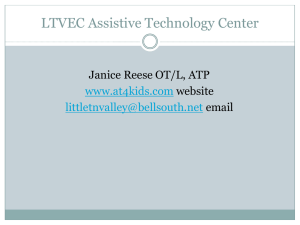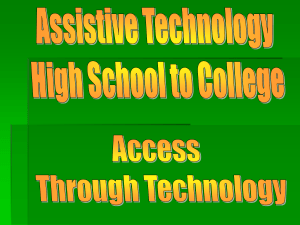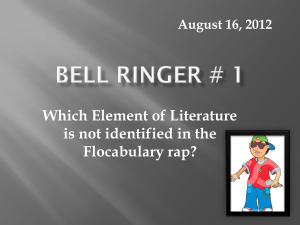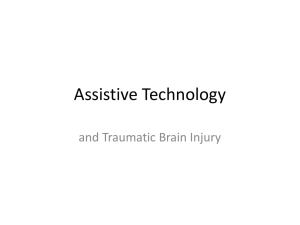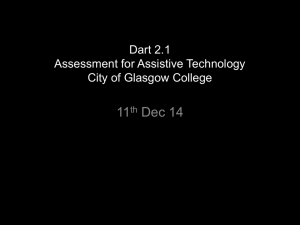Speech Recognition presentation
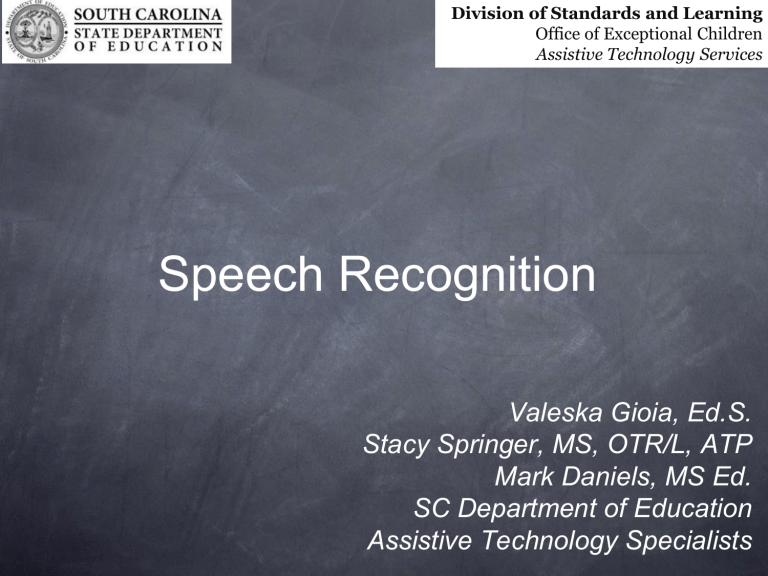
Division of Standards and Learning
Office of Exceptional Children
Assistive Technology Services
Speech Recognition
Valeska Gioia, Ed.S.
Stacy Springer, MS, OTR/L, ATP
Mark Daniels, MS Ed.
SC Department of Education
Assistive Technology Specialists
What Exactly is Speech
Recognition?
• Speech Recognition is the process of translating spoken words into text words on the computer.
• Through a speech recognition program/application, the computer is able to process words you say and turn them into text on the screen just as if you had typed them on the keyboard.
How Speech Recognition
Can Benefit Students
Dictation has the potential to improve the writing performance of students with learning disabilities by removing the barriers created by the difficulties with mechanics.
Speech Recognition
To support quality of writing
Removes the motor demands of writing
Written Productivity Profile = difficulty with both writing & keyboarding
More restrictive
Requires quiet environment, consistency is more important than articulation
Typically not used for note taking, but for homework and independent written work
Speech Recognition
To support access
For students who are not able to physically access the keyboard and mouse
Requires quiet environment, consistency is more important than articulation
Most likely require a program that provides full control of the computer (i.e. Dragon Naturally
Speaking)
Benefits and Challenges
Visual Motor
Spelling
Ergonomics
Hands-free use
Endurance
Concentration and attention
Reading and speech
Pronunciation and articulation http://www.customtyping.com
Cognitive Skills
• Proficiency in the use of speech recognition requires good levels of concentration, memory and other cognitive skills. In order for a student to use speech recognition independently, good cognitive skills are essential for memorizing commands as well as making effective use of correction strategies. http://www.customtyping.com
Consistency of Speech
Consistency of speech and pronunciation is one of the most important prerequisites for success in using speech recognition. As long as any user is able to say words and phrases in the same or similar manner each time, speech recognition programs can learn to recognize individual patterns of speech. way each time.
The user's voice quality, such as volume and pitch, and breath control should also be taken into account.
The bottom line in terms of speech, is that it should be intelligible and consistent, but it need not be perfect in terms of articulation, pronunciation and quality.
http://www.customtyping.com
Reading and Writing
Students who read at a third-grade level or higher, and who achieve scores of 1 on most of the items on the evaluation form, have extremely high potential for using speech recognition independently. In addition those students who are able to accurately isolate word recognition errors and make corrections/edit their work will do well with speech-recognition. http://www.customtyping.com
Student Evaluation Form -
Free http://www.customtyping.com/tutorials/sr/reproducible_for ms/evaluation_form_sample.htm
QIAT Resource
Quality Indicators for Assistive Technology Services
This document contains information from various sources on handwriting and/or keyboarding rates
.
http://natri.uky.edu/assoc_projects/qiat/documents/r esourcebank/hwriting_kybding_rate_info.pdf
Speech Recognition: MS Office 2003
Open MS Word → Tools → Speech
• This enables the language bar for both speech-to-text and text-to-speech options
• You will be guided through training needed to create a user voice profile (15 minutes)
• You will need a microphone
• Can dictate directly into MS Office, not other applications
Speech Recognition –
Vista and Windows 7
Built into the Operating System
Open Speech Recognition by clicking the Start button , clicking Control Panel, clicking Ease of Access, and then clicking Speech
Recognition.
Click Set up microphone, follow the instructions in the wizard.
Dictate into almost any application (i.e. word processing, internet).
Denise DeCoste’s Written
Productivity Profile http://www.donjohnston.com/products/teacher_resourc es/assistive_tech_assess/ata_worksheets.pdf
Microsoft Speech
Recognition – Windows 7
http://www.microsoft.com/enable/products/windowsvista/speech.aspx
Dragon Naturally
Speaking
http://nuance.com/dragon/index.htm
Voice Recorder with
Dragon Software
http://www.amazon.com/Sony-ICD-SX712D-Recorder-Naturally-
Speaking/dp/B004M8SU0I/ref=sr_1_2?s=electronics&ie=UTF8&qid=1325108387
&sr=1-2
Dragon Dictate for iPhone/iPad
http://itunes.apple.com/us/app/dragon-dictation/id341446764?mt=8
Dragon Remote
Microphone
http://itunes.apple.com/us/app/dragon-remote-microphone/id436624808?mt=8
Via Voice
http://www-01.ibm.com/software/pervasive/viavoice.html
Speak Q
http://www.goqsoftware.com/
Tazti Speech Recognition for
Windows XP and Windows 7
Tazti (pronounced 'tasty') features include jot-anote dictation, advanced voice search internet search sites, playing your favorite PC games, controlling iTunes, bookmark control, & web navigation. Create and use your own speech commands. http://download.cnet.com/Tazti-Speech-Recognition-
Software-for-Windows-XP/3000-7239_4-10702965.html
My Voice Controller
• My Voice Controller allows you to emulate mouse and keyboard inputs by using your voice.
• Common uses for this software are gaming and assistance for the disabled/injured.
• This software is free and is compatible with
XP and Vista. http://www.5hyphen.com/mvc/index.htm
e-Speaking Voice and
Speech Recognition
• Free Download of software
• Over 100 commands built-in
• Ability to add more commands
• Runs in Windows2000 and
Windows XP
• Utilizes latest technologies from
Microsoft
• Seamlessly integrate with Office
• Voice commands of Mouse events http://www.e-speaking.com/
Math Talk
http://metroplexvoice.com/
Comparison Chart
• Dragon Naturally
Speaking
• Speak Q
• Microsoft
Accessibility
• Dictate (MAC
Product)
http://www.pacer.org/stc/pubs/VoiceRecComparison_CTG_checks2009.pdf
http://www.pacer.org/stc/pubs/VoiceRecComparison_CTG_checks2009.pdf
Ways to Train Speech
Recognition Programs
• Reading favorite books
(consider various reading levels of students)
• Lyrics.com (clean versions)
• Poetry books
• Poetry.com
Easy to Read Dragon
Scripts
http://sccatn.wikispaces.com/
Gregory
Success vs. Effort
• An extremely important point when considering the potential use of speech recognition by students with learning and physical challenges, is that speech recognition is not a plug-and-play technology, but a complex technological solution requiring extensive training, patience, perseverance and support.
Not Appropriate for
Everyone
• Speech recognition will not work for all students, and it is important to go through an initial evaluation in order to determine if the student has the potential to cope.
A positive note about the future of speech recognition, is that since it is becoming more accurate and the technology is improving, we will find that more and more students are able to use this program in the future.
Excellent Resource for Speech
Recognition Programs http://www.customtyping.com/tutorials/sr/speech_recognition.htm
Resources
Training videos for Dragon Naturally Speaking: http://www.nuance.com/for-individuals/by-product/dragonfor-pc/existing-customers/dragon-version-11-tools-andtips/index.htm
Features and possibilities of speech recognition: http://nuance.com/for-business/by-product/dragon/productresources/features-and-demos/index.htm
Worksheets: http://www.customtyping.com/tutorials/sr/speech_recognitio n.htm
Research Articles on
Speech Recognition
• Koester, H.H. (2006). Factors that Influence the Performance of
Experienced Speech Recognition Users. Assistive Technology,
18(1): 56-76.
• Koester, H.H. (2004). Usage, Performance, and Satisfaction
Outcomes for Experienced Users of Speech Recognition. Journal of
Rehabilitation Research and Development, 41(5): 739-754.
• Koester, H.H. (2003). Abandonment of Speech Recognition
Systems. by New Users. Proceedings of RESNA 2003 Annual
Conference, Atlanta, GA. Arlington, VA: RESNA Press.
• Koester, H.H. (2002). User Performance with Speech Recognition
Systems: A Literature Review. Assistive Technology, 13(2):116-30.
South Carolina
Assistive Technology Program
The South Carolina Assistive Technology
Program (SCATP) is located in Columbia,
SC: provides state-wide resources; demonstration lab for public; free trial loan of AT devices (pay only return shipping), and annual AT Expo.
www.sc.edu/scatp
SCCATN WIKI!
SC Collaborative Assistive
Technology Network http://sccatn.wikispaces.com
Upcoming Vendor Links
FAQ
Best Practice in AT
SC Department of Education
Assistive Technology Specialists
(ATS)
Mission
• The mission of Assistive Technology Services (ATS) is to provide assistive technology support, training, consultation, equipment, and technical assistance to educators who teach students at risk of academic failure and students with disabilities.
ATS SERVICES
Professional Development
• Presentations, workshops, and trainings on assistive technology for districts and regions, both in person and online;
• Training on conducting assistive technology evaluations and assessments for local staff.
Funding Assistance
• Identification of funding sources
• Research into grant opportunities
• Formation of funding networks among AT professionals
Additional ATS Services
Technical Assistance
• Formation and support of AT teams within schools and districts
• Collaborative sessions with instructional technology specialists
• Recommendations on interventions for assisting students at risk of academic failure and students with disabilities
ENEWS – AT Connect
• News on free software, scheduled trainings, and upcoming conferences
Assistive Technology
Specialists
Coastal Region
Stacy Springer, MS, OTR/L, ATP
Charleston, SC
843-628-4542 sspringer@ed.sc.gov
Midlands Region
Valeska Gioia, Ed.S
Columbia, SC
803-316-3190 vgioia@ed.sc.gov
Upstate Region
Mark Daniels, MS, Ed.
Greenville, SC
864-355-3708 mdaniels@ed.sc.gov


